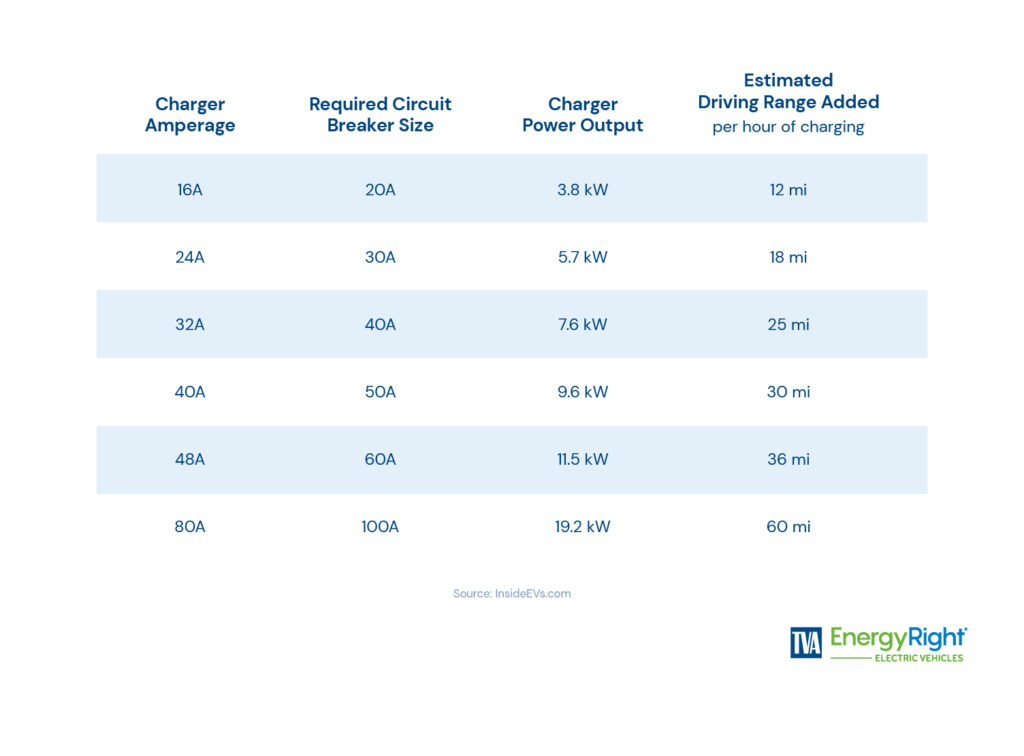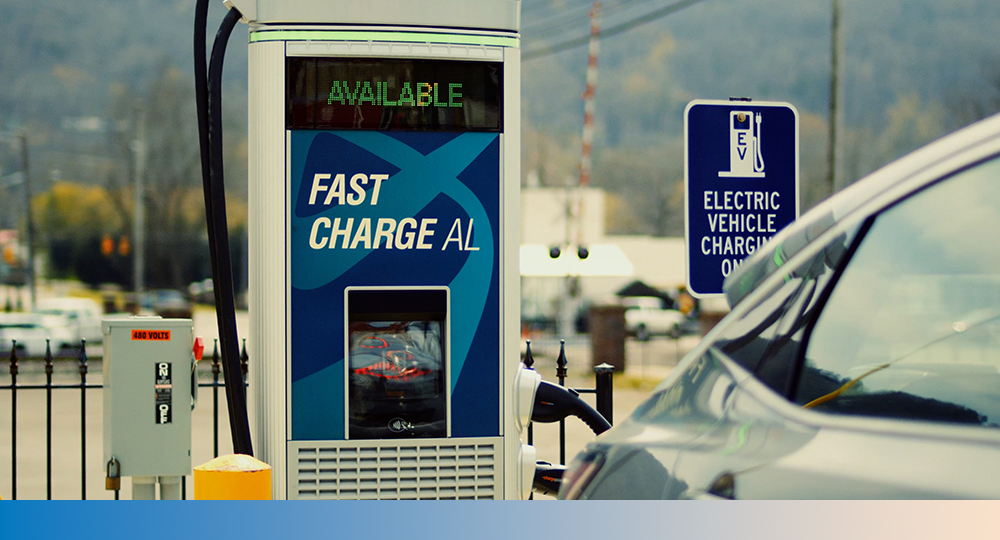Charging your EV at home: Fueling where you live.

What you need to know about charging your EV at home.
EV drivers in the Tennessee Valley region have plenty of good things to say about their vehicles and aren’t shy about sharing their top tips and tricks for EV ownership. Those who like to get from point A to point B quickly are thrilled by instant torque. Others are delighted by the fact that their cars produce zero tailpipe emissions. Some appreciate the lower overall cost of ownership and eliminating costly trips to the gas station.
Advice from EV experts for charging your EV at home
Nearly everyone we spoke to had good things to say about the convenience of charging their EVs at home. Plus, the cost of our region’s clean, reliable electricity remains lower than 70% of the nation’s top 100 utilities. When you use TVA’s nearly 60% carbon-free and locally produced electricity to fuel your car, truck, motorcycle or bicycle, filling up makes good financial sense and it’s good for the local economy.
Filling up is as easy as plugging in.
The verdict is in: Charging your electricity-fueled vehicle at home is convenient and economical. Now let’s get plugged into the ins and outs of charging your EV at home.
Charging your EV at home is one of the biggest perks to electric vehicle ownership, but first-time owners usually have plenty of excellent questions about home charging. Read on for answers, links to trusted websites and other resources to make sure you have what you need to successfully – and safely – get on with the business of charging your EV at home.
Make a plan for charging your EV at home before you bring it home.
If you’re ready to pull the plug and purchase an EV, consider starting the charger installation process before you bring your new baby home. The installation process may take up to eight weeks, depending on contractor, installation complexity and equipment availability.
What’s the best Electric Vehicle Supply Equipment (EVSE) for me?
Most new electric vehicles arrive at your doorstep with a Level 1 charger. (Can’t find it? Check the car’s trunk!) Also known as trickle-chargers, these slow-charging 120-volt devices are highly portable and great to use in a pinch or while traveling to destinations that aren’t equipped with a Level 2 charger or DC fast charger. Simply plug it into a standard wall outlet and let the juice trickle into your EV’s battery.
What do our owner friends recommend? If you routinely drive more than 30 miles a day, having a Level 2 (240-volt) home charging station – also known as an EVSE – professionally installed is recommended. (Check out Charging 101 for EV charging tips!) Level 2 charging adds about 20 to 30 miles or more of driving range per hour.
With a Level 2 charger, you can plug in your nearly depleted EV when you get home from work and take your first sip of morning coffee with the satisfaction of knowing that your battery is topped up and ready to whisk you away.

Plus, with the region’s low electricity rates, home charging is a great way to save on fuel costs.
To find the home charging station that’s right for you, visit the TVA EnergyRight Marketplace and search for EV chargers by Enervee Score®, brand, cost, customer reviews, features and more. Don’t worry! We’ll break it down for you so you can shop with confidence.
Enervee Score®
This score shows you how energy efficient a product is compared to all the other products in the category. The closer to 100, the more efficient the charger. (That is: chargers with a rating close to 100 use less energy to fill up your battery.) For EV chargers, the score is based on a combination of smart charging features and savings from electrical losses.
Home EV charging station make and model
With so many options available, it can be tough to figure out which home charger is the best. And what’s best for you and your EV may not be the best option for your neighbor. To find the right home EV charging station, we recommend reading customer reviews on the Marketplace and checking out independent reviews from trusted sources like MotorTrend, Wirecutter or Consumer Reports.
Whatever model you choose, just be sure it has a safety testing certification sticker from UL Solutions.
Cost
Although you can sort chargers by price, we don’t recommend this method – as tempting as it is! Purchasing a new car is a long-term investment and your choice of charging equipment should be, too. You should be able to choose a high-quality charger within a $500-700 range. To maximize your enjoyment, select a charger that’s efficient and well-reviewed, has the features you need and is built to fit your charging location.
NEMA electrical enclosure rating and ingress protection
The National Electrical Manufacturers Association (NEMA) defines the standards used for electrical enclosures. NEMA-rated enclosures help protect against accidental access to dangerous components and environmental hazards like water or dust. The ratings help define the types of environments (indoors or outdoors) in which an enclosure can be used.
Ingress protection (IP) ratings are defined by the International Electrotechnical Commission (IEC) and certify that an object is able to withstand a certain and specific amount of exposure to solids (like dust) and liquids (like rain). The higher the IP rating, the better protection it offers against the elements. In other words, look for an IP rating of 5 or 6 if you’re installing your charger outside.
When professionally installed and used according to manufacturer’s directions, yes, EVs are designed to charge safely in rain, snow or ice. Just be careful out there on those slippery roads!

Popular EV charging features
Not only is a Level 2 charger the fastest way to charge your EV at home, but these chargers usually come with more handy features than your standard Level 1 charger. Keep these charger features in mind as you shop:
- Wi-Fi connectivity: This gives you the ability to monitor charging remotely and receive alerts delivered to an app on your phone.
- Amp output (max power) capability: Depending on your vehicle, you may benefit from higher (or lower) output capabilities. (For more about EV batteries and why kilowatts, amps and battery capacity matters, check out our Battery Basics post.)
- Managed charging: Make sure your vehicle is powered when needed, while supporting a more reliable and resilient grid.
- Cord length: Do you need a charging cord that’s long enough to span a two-car garage?
- Cord management: This one’s for you, neat freaks. Some folks don’t mind messy cords. Others can’t stand an undressed cable. If you don’t know what “cable dressing” is, don’t worry too much about cord management. If you’re nodding your head in reverent appreciation here, look for a charger with a built-in cord management system.
- Smart assistant integration: Some chargers connect with digital assistants like Alexa or Google Assistant.
- Installation: Level 2 chargers may have multiple installation options like 14-50 plugs (like your dryer outlet plugs) or 6-50 plugs. Chargers can also be directly hardwired from the electrical box.
How can I find a trustworthy electrician to install a residential EV charger?
For peace of mind, you’ll want to find a certified electrician you can count on. Some electricians are certified by the Electric Vehicle Infrastructure Training Program (EVITP) and you can search the organization’s website to find a technician. EVSE companies like EvoCharge or ChargePoint may also be able to point you in the right direction. If they’re not certified by EVITP or a charger manufacturer, you may also want to consider asking potential contractors how many EV chargers they’ve installed to get a better sense of their level of expertise. And don’t forget to ask for references!
How much does it cost to install a home EV charger?
Charger costs can vary widely. At the time we wrote this article, chargers listed on the Marketplace ranged from $199 to $699, with an average price of $470.
According to Qmerit, an EV charging installer recommended by dozens of EV manufacturers, a typical home installation can cost anywhere from $800-$2,000, depending on job complexity, charger power and the distance between the electrical panel and the charging station.
How much does it cost to charge an EV at home?
Home electricity rates in our region are among the lowest in the country, which means that EV owners in the Valley save $20+ per refueling!
Use this formula to estimate how much fueling up with electricity will cost you:

* Find miles per kWh for common EV makes and models here.
**Example: Middle Tennessee Electric residential time-of-use (off-peak consumption plus fuel cost adjustment) rate as of 9/7/23.
SOURCE: The Washington Post
Can I use an extension cord to charge my EV at home?
We do not recommend using an extension cord because the additional cord length adds resistance and can overheat home wiring.
How many kilowatts do I need?
MotorTrend recommends 9.6 kilowatts (40 amps), noting that it will add about 29 miles per hour of charging for mid-size crossover SUVs. The more kilowatts (or amps) your charger can deliver, the faster your EV battery can charge.
However, the car itself will determine the final charging speed, no matter which charger you buy. In some instances, higher power chargers won’t necessarily charge your EV more quickly. Check out the table below to get a sense of how quickly charger amperage and power output impact charging times. But remember: Don’t buy a charger that exceeds your car’s capabilities.

Power of the plug.
Although using a NEMA 14-50 outlet (like your dryer outlet) allows you to take your charger with you if you move, most installation pros recommend hardwiring your home charger. However, if you take the plug-in installation path, use a commercial-grade plug designed for charging. Inexpensive residential outlets are not intended for 8-12 hours of EV charging and may overheat.
Can my home handle an EV charger?
If you’ve made it this far, but you’re thinking: “There’s no way my old home can support an EV charger.”
Don’t worry, you may have options! Consult with a certified electrician who can take a look at your electrical panel and service. In some instances, they’ll easily identify spare electrical capacity (amperage) and breaker space. If that’s not the case, they’ll likely have a few recommendations that’ll work for you. Some possibilities may include:
- Exploring smart energy devices that can share power between existing appliances, like your clothing dryer and your EV. (Encourage your electrician to check with local codes officials when they pull a permit for your EV charger installation.)
- Choosing a lower power (lower amperage) charger.
- Upgrading your wiring and electrical panel to accommodate a higher power (higher amperage) charger.
Go forth and start charging your EV at home!
That’s a wrap, friends. We hope we’ve covered all the basics of EV home charging and then some!
About the author: The TVA EnergyRight EV Team works diligently to make sure the people of the Tennessee Valley region have fact-based information about electric vehicles so they can decide how EVs fit into their lives. TVA is collaborating with state agencies, local power companies and other partners to pave the way for EV adoption in the region. This includes developing the Fast Charge Network, which will place public fast chargers at least every 50 miles along the interstates and major highways across TVA’s seven-state service area by 2026.
About our EV blogs: We know that big changes – like purchasing a vehicle that runs on electricity instead of gasoline – can lead to big questions. And that’s why we’re doing our best to provide expert, unbiased answers to your pressing EV questions. Each of our posts will include links to trusted external sources like automotive magazines, thought leaders, research-backed studies, government agencies and more. Feel free to click around!
DISCLAIMER: No TVA endorsement of any specific vehicle, car manufacturer, electric charger or other equipment is intended or implied. This site’s content (including, without limitation, references and links to third-party information) is based on information provided at the time of publishing, and TVA makes no warranty therein.



